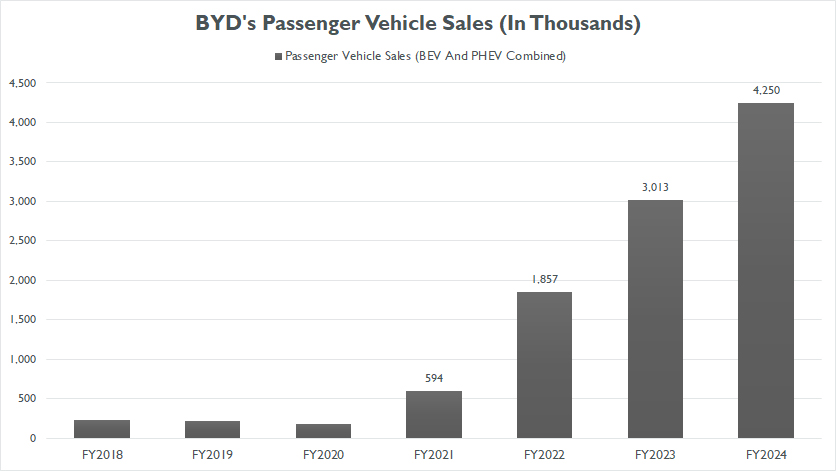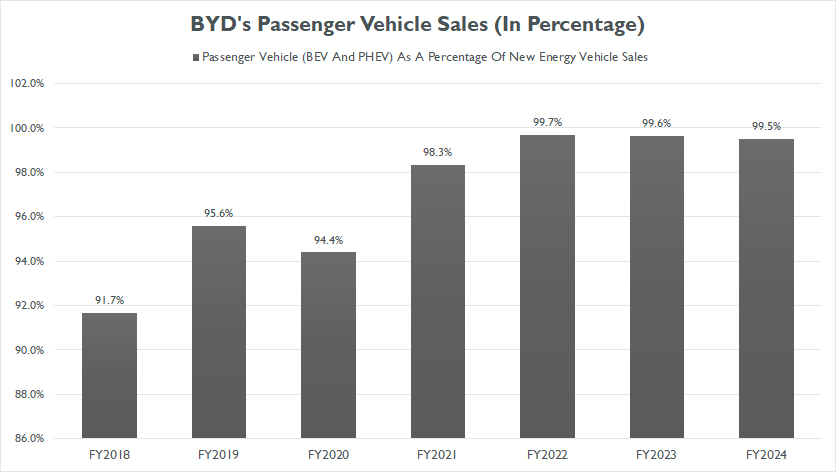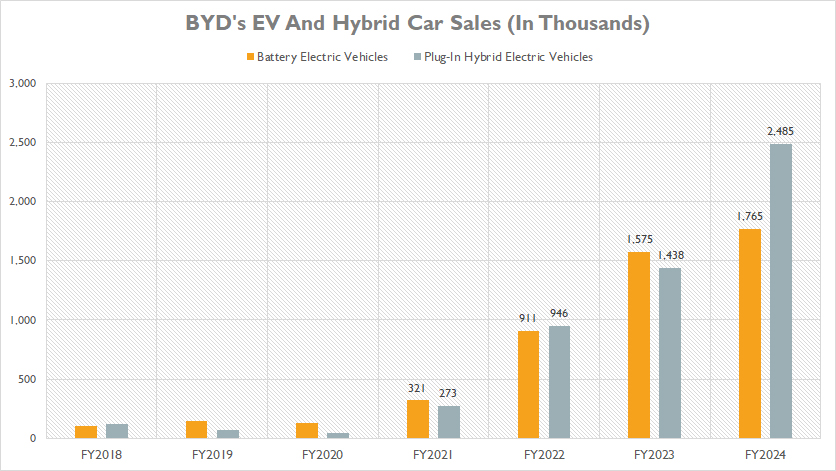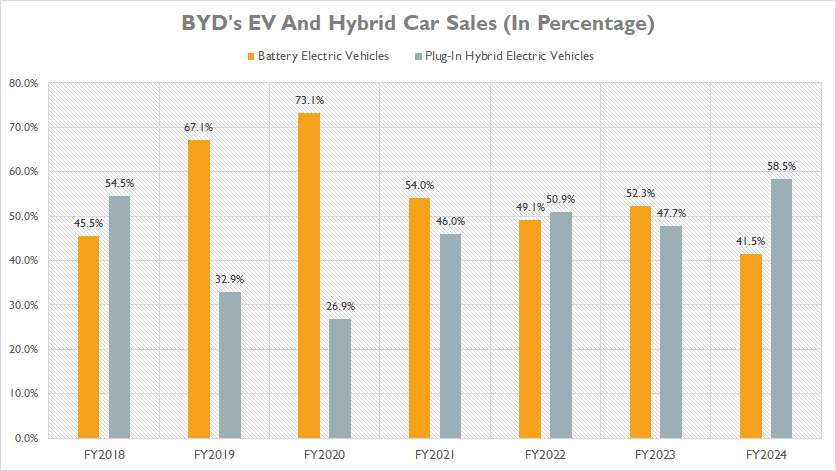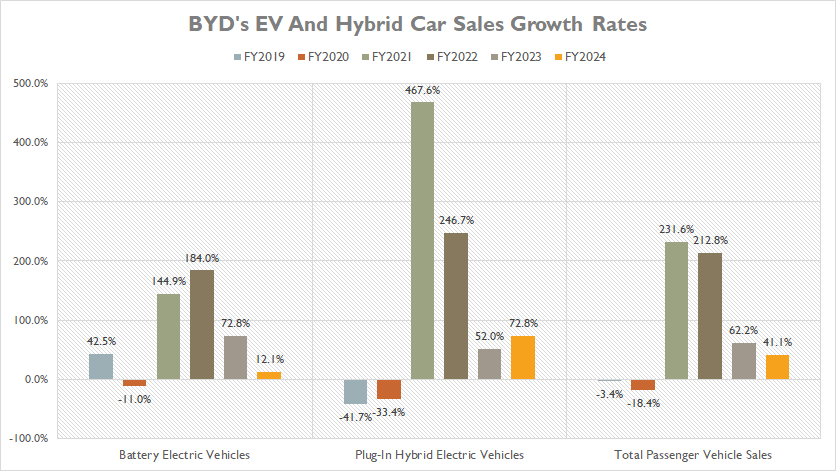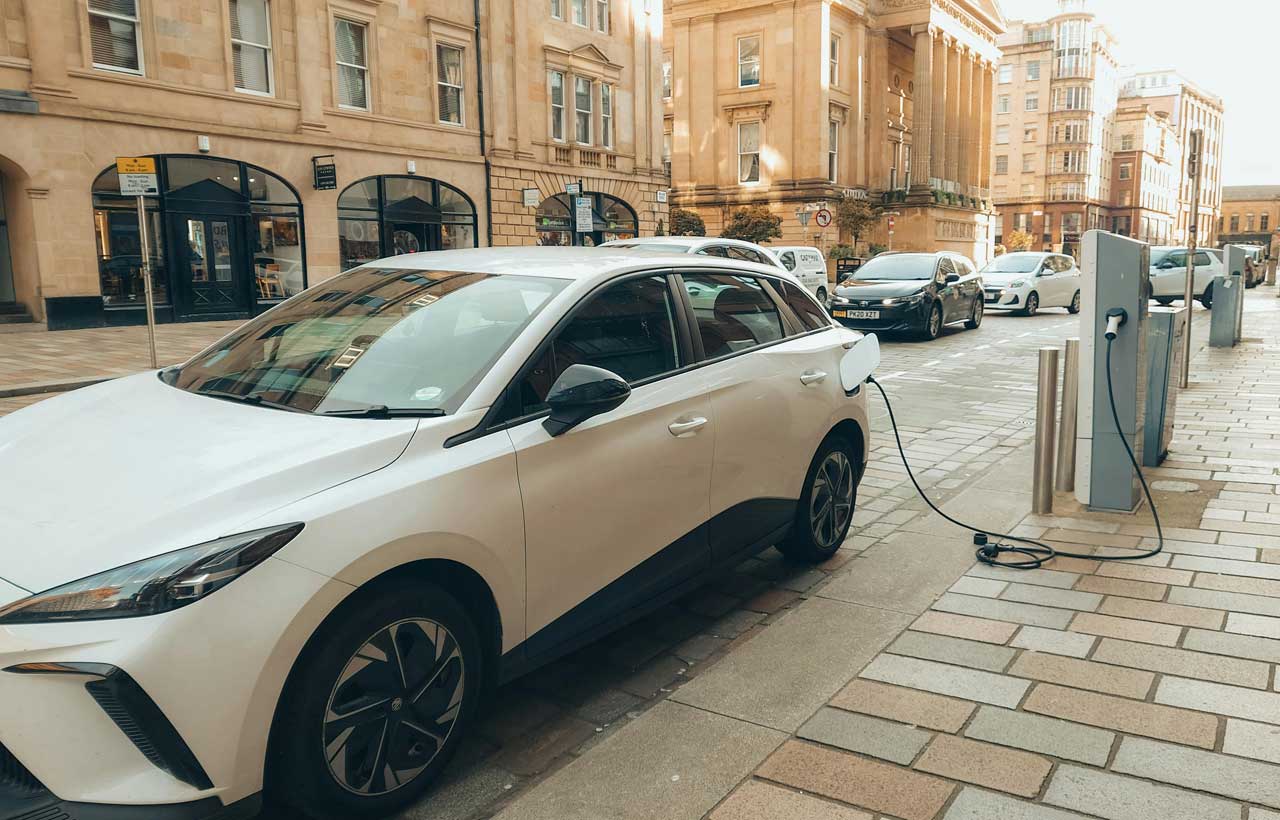
New energy vehicles. Pexels Image.
BYD has been making remarkable progress in the electric vehicle (EV) and hybrid car market. BYD sold over 4 million new energy vehicles (NEVs) in 2024, including both fully electric vehicles (BEVs) and plug-in hybrids (PHEVs). The results represent a 40% increase from the previous year.
BYD is expanding its reach in Europe, with assembly plants in Hungary and dealerships in Germany, Norway, and Sweden. BYD is the global leader in NEV sales for several consecutive year and ranked among the top 10 global automakers.
This article explores the global sales volume of BYD’s battery electric vehicle (BEV) and plug-in hybrid (PHEV) cars. Let’s get started!
Investors interested in BYD’s other statistics may find more resources on these pages:
- BYD global sales,
- BYD global revenue and revenue breakdown by segment, and
- BYD commercial vehicle sales.
Please use the table of contents to navigate this page.
Table Of Contents
Definitions And Overview
- Passenger Vehicles Segment
- Battery Electric Vehicles (BEVs)
- Plug-In Hybrid Electric Vehicles (PHEVs)
Consolidated BEV And PHEV Sales
A1. Passenger Vehicle Sales
A2. Passenger Vehicle Sales As A Percentage Of The NEV Volume
Passenger Vehicle Sales By Category
B1. BEV And PHEV Sales
B2. Percentage Of BEV And PHEV Sales To Total Passenger Vehicle Volume
Growth Rates
C1. Growth Rates Of BEV And PHEV Sales
Conclusion And Reference
S1. Conclusion
S2. References and Credits
S3. Disclosure
Definitions
To help readers understand the content better, the following terms and glossaries have been provided.
Passenger Vehicles Segment: BYD’s passenger vehicle segment focuses on the design, production, and sale of electric passenger vehicles and plug-in hybrid electric vehicles (PHEVs). This segment is part of BYD’s broader strategy to promote new energy vehicles (NEVs), which include battery electric vehicles (BEVs) and PHEVs.
Battery Electric Vehicles (BEVs): BYD has an extensive range of BEVs, each designed to cater to different customer needs and preferences. Here are some of the standout models:
- BYD Han EV: A premium sedan that boasts a sleek design, advanced technology, and impressive performance. It offers a high range on a single charge and comes equipped with BYD’s Blade Battery.
- BYD Tang EV: A spacious and stylish SUV that provides a comfortable ride, powerful performance, and a range of cutting-edge features. It’s well-suited for families and adventure enthusiasts.
- BYD Dolphin: A compact and affordable electric hatchback that is perfect for city driving. It’s known for its efficiency, practicality, and eco-friendliness.
- BYD e6: An electric MPV that is widely used in taxi and ride-hailing services. It offers ample space, durability, and a long range, making it ideal for commercial use.
- BYD Seagull: The BYD Seagull is a compact, fully battery-electric city car designed to be a practical and affordable option for urban driving. The starting price is around $9,700 (69,800 yuan) in China, making it one of the most affordable electric vehicles in the market.
BYD’s BEVs are generally considered affordable, especially when compared to other electric vehicles on the market. For example, the starting price for the Dolphin EV is around $13,900 and the starting price for the Qin Plus EV is around $15,200 (109,800 yuan).
Plug-In Hybrid Electric Vehicles (PHEVs): BYD’s Plug-In Hybrid Electric Vehicles (PHEVs) combine an internal combustion engine (ICE) with an electric motor, allowing them to run on both electricity and gasoline. Here are some popular BYD’s PHEV models:
- BYD Qin Plus DM-i: A compact sedan that offers a balance of efficiency and performance. It features a 1.5-liter turbocharged engine combined with an electric motor, providing a combined range of over 1,000 kilometers (621 miles) on a full charge and a full tank of gas.
- BYD Song Plus DM-i: A mid-size SUV that combines the benefits of an SUV with the efficiency of a PHEV. It offers a spacious interior and a long driving range.
- BYD Tang DM-i: A larger SUV that provides ample space and power, making it suitable for families and long-distance travel.
BYD’s PHEVs are priced competitively, making them accessible to a wider range of consumers. For example, the base price for the BYD Qin L is around $13,775 (99,800 yuan).
Passenger Vehicle Sales
byd-combined-sales-of-bev-and-phev
(click image to expand)
BYD’s sales of BEV and PHEV fall under the passenger vehicle segment. BYD’s passenger vehicle segment is part of the larger new energy vehicle (NEV) segment, which also encompasses the commercial vehicle segment.
On a consolidated basis, BYD delivered 4.3 million passenger vehicles, including both Battery Electric Vehicles (BEV) and Plug-in Hybrid Electric Vehicles (PHEV), in fiscal year 2024. This marked a substantial 40% increase from the 3 million vehicles sold in 2023. This impressive growth trend continued from fiscal year 2022, when BYD’s sales skyrocketed to 1.9 million passenger vehicles, over three times the 600,000 vehicles sold in 2021.
Before this explosive growth, BYD’s annual distribution of passenger vehicles was relatively modest, consistently below 500,000 vehicles until 2021. The significant leap in sales from 2022 onwards highlights a shift in market dynamics and consumer preference, favoring BEVs and PHEVs.
BYD’s expansion is also underpinned by strategic investments in R&D and infrastructure, enhancing their production capacity and technological innovation. By fiscal year 2024, BYD’s accomplishment of delivering over 4 million BEVs and PHEVs represents a record-breaking sales figure, underscoring the company’s strengthening market position and growing consumer confidence in its electric vehicle offerings.
The surge in demand for BYD’s electric vehicles can be attributed to several factors. First, BYD’s continuous innovation in battery technology and electric drivetrains has made their vehicles more appealing.
Second, various government policies promoting green energy and offering subsidies for electric vehicle purchases have boosted sales. Third, there is a growing consumer shift towards environmentally friendly and cost-effective transportation solutions.
Lastly, BYD has strategically expanded its global footprint, entering new markets and establishing a strong international presence. This phenomenal growth trajectory positions BYD as a leading player in the global electric vehicle market, showcasing its ability to scale production and meet rising consumer demand effectively.
Passenger Vehicle Sales As A Percentage Of The NEV Volume
byd-combined-sales-of-bev-and-phev-in-percentage
(click image to expand)
BYD’s sales of BEV and PHEV fall under the passenger vehicle segment. BYD’s passenger vehicle segment is part of the larger new energy vehicle (NEV) segment, which also encompasses the commercial vehicle segment.
BYD’s sales of Battery Electric Vehicles (BEVs) and Plug-in Hybrid Electric Vehicles (PHEVs) within the passenger vehicle segment account for nearly the entirety of the company’s New Energy Vehicle (NEV) volume. This dominance is vividly illustrated in the accompanying chart.
In fiscal year 2024, BYD’s passenger vehicle segment contributed a striking 99.6% of the total sales in the NEV segment, maintaining a consistent ratio observed in 2023. This consistent performance underscores the pivotal role of the passenger vehicle segment in the company’s overall NEV sales.
The proportion of sales from the passenger vehicle segment has seen a remarkable increase, rising from 91.7% in 2018 to nearly 100% in 2022. This trend has continued steadily from fiscal year 2022 through 2024, highlighting the significant and sustained growth of BYD’s passenger vehicle segment.
This impressive growth trajectory reflects BYD’s strategic focus on the passenger vehicle market and its success in capturing consumer demand for BEVs and PHEVs. The company’s commitment to innovation, quality, and expanding its electric vehicle lineup has solidified its position as a leader in the NEV market, with the passenger vehicle segment at the forefront of this success.
BEV And PHEV Sales
byd-electric-vehicle-and-hybrid-car-sales
(click image to expand)
BYD’s passenger vehicle segment consists of two categories of vehicles: BEV and PHEV. The definitions of BYD’s BEV and PHEV are available here: battery electric vehicle (BEV) and plug-in hybrid.
In fiscal year 2023, BYD delivered nearly the same number of electric vehicles and hybrid cars, with 1.6 million Battery Electric Vehicles (BEVs) and 1.4 million Plug-in Hybrid Electric Vehicles (PHEVs). This balance reflected a similar trend observed in fiscal year 2022, when BYD sold 911,000 BEVs and 946,000 PHEVs, demonstrating an almost equal distribution between the two types of vehicles.
However, a significant shift occurred in fiscal year 2024, with the sales of plug-in hybrid cars notably outperforming battery electric vehicles. During this period, BYD delivered approximately 1.8 million BEVs, while hybrid vehicle sales surged to 2.5 million units. This marked a clear departure from the previous balance, highlighting a growing consumer preference for hybrid models.
Before fiscal year 2022, BYD’s distribution of both battery electric vehicles and hybrid cars had been relatively modest, with fewer than 500,000 units sold each year. The substantial growth in sales figures since then underscores the company’s successful expansion and increasing market share in the electric and hybrid vehicle segments.
BYD’s ability to adapt to market demands and innovate within the electric vehicle landscape has been crucial to its success. The company’s focus on developing advanced battery technologies and efficient hybrid systems has resonated with consumers, leading to the impressive sales figures seen in recent years. This trend is expected to continue as BYD further strengthens its position as a leading player in the global new energy vehicle market.
Percentage Of BEV And PHEV Sales To Total Passenger Vehicle Volume
byd-electric-vehicle-and-hybrid-car-sales-in-percentage
(click image to expand)
BYD’s passenger vehicle segment consists of two categories of vehicles: BEV and PHEV. The definitions of BYD’s BEV and PHEV are available here: battery electric vehicle (BEV) and plug-in hybrid.
Historically, BYD’s sales of battery electric vehicles (BEVs) have made up the majority of its total passenger vehicle volume. From fiscal year 2019 to 2021, BEV sales consistently represented more than 50% of BYD’s total passenger vehicle sales, underscoring the company’s early leadership in the electric vehicle market.
However, this dynamic began to shift in fiscal year 2022, when the sales of BEVs and plug-in hybrid electric vehicles (PHEVs) reached an equal proportion. For instance, during fiscal years 2022 and 2023, BYD’s sales of BEVs and PHEVs each made up roughly 50% of the total passenger vehicle volume. This balance demonstrated BYD’s growing versatility in catering to diverse consumer preferences for both fully electric and hybrid vehicles.
The trend saw a significant shift in fiscal year 2024, with plug-in hybrid cars gaining prominence. During this period, BYD’s sales of PHEVs accounted for a substantial 59% of the total passenger vehicle volume, while BEV sales made up only 42%. This shift indicates a rising consumer preference for the flexibility and extended range offered by hybrid models, reflecting changes in market dynamics and consumer demands.
The evolution of BYD’s sales distribution highlights the company’s ability to adapt and innovate within the electric vehicle market. By expanding its offerings to include a balanced mix of BEVs and PHEVs, BYD has successfully captured a broader market segment and strengthened its position as a leading player in the new energy vehicle industry. This adaptability and strategic focus on meeting consumer needs have been crucial to BYD’s sustained growth and success.
Growth Rates Of BEV And PHEV Sales
byd-growth-rates-of-electric-vehicle-and-hybrid-car-sales
(click image to expand)
BYD’s passenger vehicle segment consists of two categories of vehicles: BEV and PHEV. The definitions of BYD’s BEV and PHEV are available here: battery electric vehicle (BEV) and plug-in hybrid.
The data clearly demonstrates that BYD’s hybrid car sales growth has significantly outperformed its battery electric vehicles (BEVs). On average, from fiscal year 2020 to 2024, BYD’s sales of plug-in hybrid vehicles (PHEVs) have grown at an impressive annual rate of 161%, compared to an annual growth rate of only 81% for BEVs over the same period. This stark contrast highlights the increasing consumer preference for PHEVs, driven by factors such as extended driving range and the flexibility of hybrid technology.
The trend is particularly evident in fiscal year 2024, where BYD’s hybrid car sales surged by 73% year-over-year, while BEV sales grew by a modest 12%. This significant disparity underscores the rapid adoption and growing market share of hybrid vehicles within BYD’s product lineup.
The remarkable growth in PHEV sales can be attributed to several factors. First, BYD’s continuous advancements in hybrid technology have made their PHEVs more appealing to consumers seeking a balance between electric driving and the convenience of traditional fuel options. Second, government incentives and policies promoting the adoption of hybrid vehicles have played a crucial role in boosting sales. Lastly, the increasing awareness and demand for environmentally friendly transportation solutions have further propelled the popularity of PHEVs.
In contrast, while BEVs have also experienced growth, the pace has been more restrained. This could be due to various factors such as charging infrastructure limitations and consumer concerns about range anxiety. However, BYD’s ongoing efforts to enhance battery technology and expand charging networks are expected to drive future growth in BEV sales.
Overall, the data highlights the dynamic and evolving nature of the new energy vehicle market, with BYD’s hybrid cars taking the lead in recent years. This trend showcases BYD’s ability to adapt to market demands and innovate within the electric and hybrid vehicle landscape, solidifying its position as a prominent player in the industry.
Conclusion
Overall, BYD’s strategic focus on innovation, quality, and market adaptation has enabled it to achieve significant growth and establish a strong position in the global new energy vehicle market. This trend is expected to continue as BYD continues to innovate and expand its offerings to meet evolving consumer demands.
References and Credits
1. All financial figures presented were obtained and referenced from BYD’s monthly production and sales reports published on the company’s investor relations page: BYD Latest Announcement.
2. Pexels Images.
Disclosure
We may use the assistance of artificial intelligence (AI) tools to produce some of the text in this article. However, the data is directly obtained from original sources and meticulously cross-checked by our editors multiple times to ensure its accuracy and reliability.
If you find the information in this article helpful, please consider sharing it on social media. Additionally, providing a link back to this article from any website can help us create more content like this in the future.
Thank you for your support and engagement! Your involvement helps us continue to provide high-quality, reliable content.

